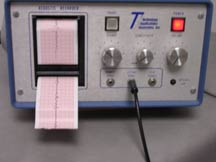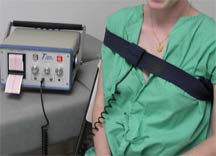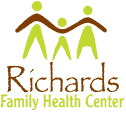The Phonocardiogram to Customize Your Nutrient Needs
In light of the fact that cardiovascular disease is the number one cause of death and illness in the US, I think finding a way to assess the heart's functional status at the earliest possible time is incredibly important. The phonocardiogram is a tool which will tell much more about a person's health than "just" the state of the heart.Today, the alternative health care paradigm is shifting to wellness - providing what the body needs to perform optimally and reversing deficiencies before the onset of a symptom pattern which can be termed a "disease." Most of us want to stay well, rather than "get" well.
At the beginning of this century, diet was considered the single most important factor which influenced health, and the emphasis was on adjusting the nutritional intake to relieve symptoms the moment they appeared. Symptoms were considered an early- warning system of nutrient malnutrition - very perceptive, don't you agree!!
It was during this time that the heart was found to be a very useful and reliable indicator of the state of an individual's overall health. When challenged with nutrients, the heart reacts and adapts within seconds, clearly indicating whether a nutrient is "heart friendly," "heart aversive," or "heart neutral."
Responding to a need to develop tools which could accurately record and measure the heart cycle, Dr. Royal Lee, a dentist by education and an inventor by profession, designed and introduced in 1937 the first phonocardiogram - which he called the Endocardiograph. By providing a recording of the heart sounds, the Endocardiograph allowed documentation of the heart's responses - leading to accurate and detailed evaluation.
 In 1987, the instrumentation was further refined by Drs. Goodheart and Schmidt, resulting in the modern phonocardiogram in use today - the Acoustic CardioGraph (ACG). The ACG records the sounds of the heart as the blood moves through the various chambers, valves and vessels. The graph signature reflects the opening and closing of the valves, the contraction and strength of the heart muscle and the efficiency of the movement of the blood supply - all in present time. To the experienced eye, it also reflects the organization of the heartbeat (which reflects the electrical conduction system) and the length of the resting cycle. It also documents arrhythmias and heart murmurs. Furthermore, adrenal function, the efficiency of the calcium ion exchange and the effect the liver may be having on the heart can all be determined.
In 1987, the instrumentation was further refined by Drs. Goodheart and Schmidt, resulting in the modern phonocardiogram in use today - the Acoustic CardioGraph (ACG). The ACG records the sounds of the heart as the blood moves through the various chambers, valves and vessels. The graph signature reflects the opening and closing of the valves, the contraction and strength of the heart muscle and the efficiency of the movement of the blood supply - all in present time. To the experienced eye, it also reflects the organization of the heartbeat (which reflects the electrical conduction system) and the length of the resting cycle. It also documents arrhythmias and heart murmurs. Furthermore, adrenal function, the efficiency of the calcium ion exchange and the effect the liver may be having on the heart can all be determined.This plethora of detail allows the doctor to evaluate functional physiology at a cellular level, using the hardest working organ in your body - your heart. Since the heart works constantly, it has the most urgent need for optimum nutrition. Nutrient changes which affect heart cells will, inevitably, be reflected elsewhere in the body, as well.
There are two questions which are commonly asked about the ACG. The first is: "Doctor, I've had an EKG and it was normal. Why do I need an ACG?' To answer, let me briefly contrast the EKG with an ACG. The EKG records the surface electrical impulse as it moves through the nerves of the heart tissue. The only thing it can reveal is whether or not there has been damage to the electrical conduction system. For example, after a heart attack, the heart muscle repairs itself by forming scar tissue in the area of the heart attack. Scar tissue does not conduct the electrical impulse; therefore, an EKG can tell if you have ever had a heart attack. You might say that an EKG reveals history, while an ACG reveals the present, and the future.
 So, to answer your question: "Great! If your EKG is normal, you have had no damage to your heart. Now, we need to know whether there's a process at work that may cause damage in the future so that we can avert it."
So, to answer your question: "Great! If your EKG is normal, you have had no damage to your heart. Now, we need to know whether there's a process at work that may cause damage in the future so that we can avert it."The second question is: "I don't have a heart problem. Why do I need a phonocardiogram?" Actually, the answer is the same: "If we optimize the health of your heart, you may never suffer from heart trouble." This aside, ferreting out the details is very exciting! I have found that the phonocardiogram is the most valuable tool I have to customize your nutrient needs. A blood panel can give me a list of nutrients you apparently need - the nutrients which research has proven are effective for your particular condition. However, the ACG allows me to find out which of those nutrients you personally need to normalize cellular function.
When I did a pilot study, no one has actually needed to take every nutrient indicated by the blood work. In some cases, one or two out of three or more recommended by the blood profile actually corrected the heart cycle. In a few cases, we have had to alter the form of the nutrient - IntrinsiB 12 Folate, instead of sublingual Resin B 12, for example. In some people, the phonocardiogram turned up heretofore undiagnosed deficiencies.
The entire process has been tremendously exciting, because it is just further confirmation of what I teach and believe - we are all biochemically unique! Supplying each of us with our unique requirements can only result in healthier and happier lives.
[see Personal Supplement Programs]
Does this seem helpful? If so, see our information on Consultations.
[TOP]
Case Profile
Case Profile (Phonocardiogram)One of our patients was unable to share her personal story. She's 97 now and doesn't write much. She, too, has congestive heart failure. She was in a nursing home for a couple of months this year, while her daughter relocated them from a house to a more manageable apartment. It was a frightening experience. She couldn't take her supplements, and she became almost moribund. When she came home we immediately did a new phonocardiogram to assess her nutrient needs. Her 76 year-old daughter was in the office this week and told me her mother is getting stronger every day. In fact, her daughter's opinion, her mother was doing better than she was! Again, the proper nutrients based on accurate phonocardiogram diagnosis have made the difference for her. --Dr. Richards
Case Profile (Phonocardiogram, Heart)
Hi, my name is Tom and I suffered from congestive heart failure and on 11/5/96 my blood pressure was uncontrollable. I had so much difficulty in breathing I was always puffing and puffing. I was grossly overweight. (I was retaining so much water). After being hospitalized I lost 25 pounds, but I was still hulling and puffing, and I was so weak. My blood pressure was now totally out of control, and I was doing everything the Kaiser doctors were telling me to do (limiting my salt intake, taking my medication regularly and not exerting myself).
My wife recommended I see Dr. Richards. I started to feel a little better, and I was still taking the medication from the Kaiser doctors, and on 4/12/97 1 had a mini stroke. I could not speak, my right hand became useless and I was hospitalized again. My wife said, "You better get your butt over to see Dr. Richards." I did, and I am glad I did. Dr. Richards treated me and BAM I started not only feeling better, I began to feel good (my kidneys kicked in, I was urinating again and that is a good thing). I no longer had shortness of breath - I was strong as a bull again.
I recently saw my buddy Charles, and he was dragging and he complained about his health and his high blood pressure, and I said to Charles, "If you ever want to date again, you better get your butt over to see Dr. Richards." I am telling anyone reading this, if you are feeling bad and you are in poor health, YOU BETTER GET YOUR BUTT OVER TO SEE DR. RICHARDS! --Tom V
Tom's case is one of those medical miracles. Malignant unresponsive hypertension coupled - with congestive heart failure has a very poor prognosis medically. In Tom's case, I utilized the nutrients from the phonocardiogram protocol for both congestive heart failure and hypertension, and you see the results. I can sincerely say that the proper nutritional supplements are far more effective than cardiac medications in almost every case. --Dr. Richards
[TOP]
© 2013, Dr N Rowan Richards. This site or any part may not be reproduced without the written consent of Richards Family Health Center. N Rowan Richards, DC, DABCI, FIACA at 727 Lee Court, Twin Falls ID 83301. 626.303.3162. email:frontoffice@richardsfamilyhealth.com. This site is Not intended to dispense health advice or serve as a substitute for actual patient contact with a qualified healthcare provider. Our sole purpose is one of education. It is our expectation that our site can educate our visitors about the efficacy of some healthcare treatments that exist as an alternative to conventional medical wisdom.
PRIVACY POLICY: Richards Family Health Center takes your privacy very seriously. Be assured that we do not sell or rent your contact information to anyone.


